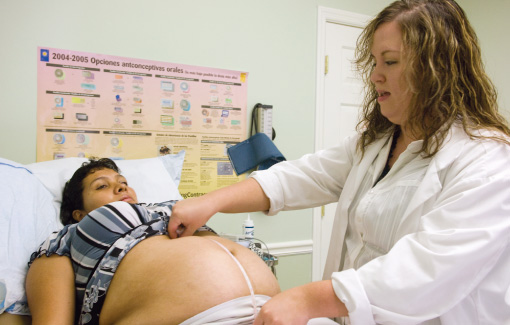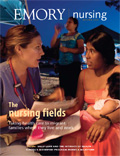A special delivery 30 years in the making

by Kay Torrance
School’s midwifery program marks a milestone
|
|
The ledge in front of Jane Mashburn’s office window is full of cards she has received from former patients. Thank you-notes with baby photos enclosed. Christmas cards with family pictures. They are from mothers whose babies Mashburn has helped deliver. The women have remembered Mashburn long after the birth date. When asked about the cards, her eyes fill with tears. "When I think about being there at such an important life event..," she says, as her voice trails off.
Mashburn, 78MN, has delivered many babies in the years since graduating from the midwifery program of the School of Nursing. She was one of eight students in the first class. Now she oversees the education of future midwives as director of the program, which celebrates its 30th anniversary in 2008.
It is the only midwifery program in Georgia and has graduated more than 300 nurse midwives since its inception. But it’s a relatively small program where faculty and graduates remember each other. Mashburn still keeps all her roll call booklets from past years and can tick off "who’s who" as she reads down the lists.
Midwifery, in general, is a small community, since the number of midwives has decreased in recent years. Since the late 1980s, it has faced its share of challenges, with shifts in health care funding and support.
When Grady delivered
Back in 1977, Mashburn and other midwifery students trained at Grady Hospital. Grady’s midwives delivered, on average, 200 babies a month, most to low-income women. Those were the days before private doctors accepted Medicaid, and most low-income women delivered at public hospitals.
"We had a large, vibrant midwifery practice at Grady," says Maureen Kelley, a midwife and chair of the school’s department of family and community nursing. "It was ideal. We had students teamed with faculty there for most of the students’ first year."
A decade later though, Grady like other public hospitals across the country, saw fewer and fewer low-income expectant mothers. States increased Medicaid reimbursements, and low-income patients became more financially attractive to private doctors. Subsequently, the number of midwives at Grady was greatly reduced. Grady still serves as a place to train, though it only takes 1 to 2 Emory midwifery students a year. Similarly, the midwifery program at Emory Crawford Long Hospital, which Kelley started in 1983, closed two years ago.
"Health care is focused on productivity," Kelley says. "Doctors see patients every five or 10 minutes. They don’t get to know a person’s nutrition, behaviors, or home life, for example. Midwives provide a continuity of care that takes more time."
Both she and Mashburn, who also practiced there, hope the Crawford Long program will be revived, as the demand grows for personalized health care.
The school’s midwifery program is continually on the lookout for more suitors—practices with midwives willing to serve as preceptors. "We also want to find practices where students can really practice midwifery and not be a junior doctor," says Mashburn, who points out that accreditation standards require students to be precepted by a midwife and not a doctor.
"They have to be willing to take a student at 3 pm or 3 am," adds Kelley. "It’s a big commitment."
A special calling
Midwifery is a niche field, and that is just fine with its practitioners. They say they love what they do and are providing much-needed service and care that doctors do not. Not every nurse can become a certified midwife, though, because midwifery is a special calling, they say.
It takes a nurse with an extra dose of stamina and compassionate caring. It also takes a nurse willing to commit to the lifestyle.
Some younger nurses forgo midwifery in favor of other areas of nursing that offer a more regular schedule. Kelly Moynes Sklare, 04N, 06MN, says she remembers some of her classmates being a little leery of the midwifery field, but she knew from the get-go that that was where she should be.
"When I was in the psychology field, I was working with people who were really ill," she says. "I did it for two reasons. I was compassionate, and I also was interested in it. What I like about midwifery is that it is really health care, not sick care. It doesn’t focus on disease but on the whole health care of a woman. But there also has to be something in it that is meeting a nurse’s need. There has to be intellectual stimulation, in addition to the desire to give loving care."
The school has seen the number of applications to the program decline slightly over the years, though its student roster is full every fall. Nationwide, the number of midwifery education programs has declined from 50 in 1998 to 41 in 2005.
"Many in the younger generation don’t want the lifestyle," Mashburn says. "It’s pretty difficult to be on call 24 hours a day. But I felt like it was worth it. It gave me great stories to tell my students."
"You really love it, or it’s not for you," says Heather Woodall, 07MN. "There is no middle ground. It’s a life in itself. You have to love it to get into it. You have to have that kind of mindset."



